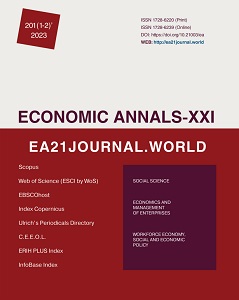Economic viability and market potential of combined intermediate moisture dairy products production in Kazakhstan
Economic viability and market potential of combined intermediate moisture dairy products production in Kazakhstan
Author(s): Tamara Tultabayeva, Urishbay Chomanov, Zhumatai Urazbayev, Gulmira Kenenbay, Aruzhan Shoman, Asiya ShomanSubject(s): Economy, Business Economy / Management, Micro-Economics, Economic development
Published by: Institute of Society Transformation
Keywords: Economic Development; Dairy Industry; Combined Dairy Products; Intermediate Moisture Dairy Products; Market Competition; Value Added;
Summary/Abstract: In recent years, the Republic of Kazakhstan has prioritized the enhancement of its domestic food production industry as a strategic economic initiative. This is driven by the dual goals of improving public health outcomes and stimulating economic growth. Dairy products, a staple in the Kazakh diet, have been identified as a key sector for development. However, the domestic dairy industry faces significant economic challenges. Firstly, the industry is in its nascent stages of recovery following a prolonged period of economic stagnation. Secondly, high-quality domestic dairy products are facing stiff market competition from inexpensive foreign imports, which often do not meet the necessary quality and nutritional standards. This has implications for both public health and the economic viability of domestic dairy producers. Thirdly, the country is at the initial stages of exploring combined technologies to produce dairy products enriched with herbal supplements, known as combined dairy products. This emerging sector represents a potential avenue for economic diversification and value addition within the dairy industry. The objective of the study outlined in the provided paper is multifaceted, encompassing economic, technological, and public health dimensions within the context of Kazakhstan’s domestic dairy industry. Specifically, the study aims to explore the economic potential and viability of producing combined cheeses with intermediate moisture content. To achieve this objective, we propose to examine the organoleptic and physico-chemical characteristics of such dairy products. By investigating these attributes, the study seeks to shed light on the implications of producing these combined cheeses for production costs, marketability, and potential profitability. This endeavor is situated within the broader strategic goal of enhancing Kazakhstan’s domestic food production industry, particularly focusing on dairy products, which are a staple in the Kazakh diet. The research is driven by dual imperatives: improving public health outcomes and stimulating economic growth. To gain empirical data and real market needs understanding, the authors conducted a poll of the residents of three major cities of Kazakhstan: the capital Astana, Almaty and Shymkent. The poll involved 1,000 residents of each of the named cities, which is approximately 0.5-1% of the population of such cities as of 2020. The poll was conducted over a one-month period among supermarket customers of different ages who choose dairy products – soft cheeses. Respondents were asked three questions, namely: In your opinion, is there a need in the Republic of Kazakhstan to produce a new dairy product, in particular soft cheese, with high vitamin content and low-fat content, based on organic fermented vegetables? What price would you be willing to pay for such a product? Should the new product be produced by national producers? The findings show that almost every resident of large cities of the Republic of Kazakhstan who buys soft cheese wants to see on the supermarket shelves more high-quality and useful national cheeses. The above study of consumer opinion on the need for high-quality soft cheese with vegetable additives suggests that in terms of production of new soft cheeses market can be called promising. The results of economic analysis example presented in our paper also support this conclusion.
Journal: Економічний часопис - ХХІ
- Issue Year: 201/2023
- Issue No: 1-2
- Page Range: 44-55
- Page Count: 12
- Language: English

